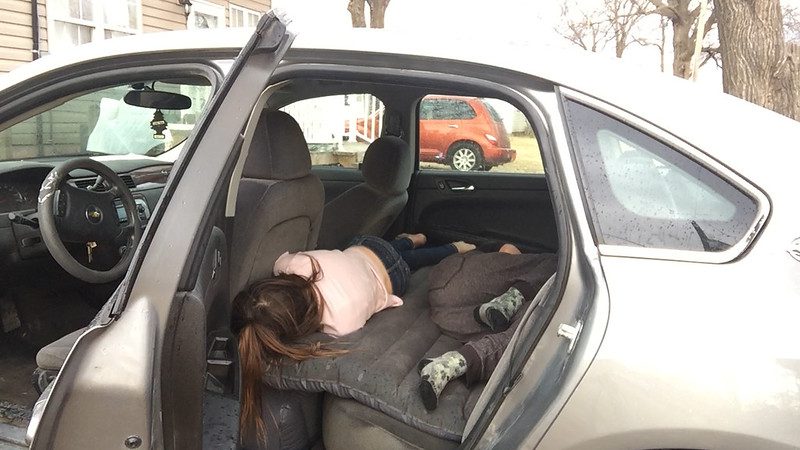
Photo by Flickr user The Sleep Judge, CC BY 2.0
Student transience has received scant attention in the extensive literature about educational problems in the United States. Yet research indicates that students who are highly mobile acquire basic skills at a slower pace, which ultimately increases their chances of school failure and dropout. Behavioral and interpersonal problems also arise. Students who have moved more than three times over a period of six years can fall a full academic year behind their peers. As long as the classroom is a revolving door with a high proportion of students leaving and arriving during the school year, essential improvements – such as smaller schools and classrooms and better trained teachers – will have little positive effect on student performance.
Communities receiving large numbers of immigrants experience a steady influx of children entering the school system throughout the year. But student mobility is also disproportionately higher among low-income, minority, homeless, and farm worker children. For these students, the inadequacy of the education they receive is grossly magnified.
The principal cause of student transience is housing instability. Families who are poor move 50 to 100 percent more frequently than families who are not poor. Homelessness is a major reason that children must change schools. Residency rules and lack of transportation exacerbate their situation.
Research suggests that those who leave the welfare rolls are more likely to be mobile than those who remain on welfare, in some instances because employment opportunities require or prompt a move. People who leave welfare are also somewhat more likely to have trouble paying rent, to be evicted or to move in with another family.
Migrant families typically move temporarily from a home-base community to other communities within the state or other states, following harvests and crop-related agribusiness in migrant streams. According to a report in Title I Monitor, “[T]he mobility of migrant children plays havoc on the planned schedules of this nation’s schools. These children ping-pong from school to school, swelling classrooms for often brief periods until they leave again.” Migrant children often face barriers to enrolling in school and have difficulty accumulating the academic credits necessary to complete high school.
Government’s Minimal Role
Despite overwhelming evidence of the magnitude and deleterious effect of student mobility, the government has played a minimal role in addressing the issue. Funding that states receive through the Elementary and Secondary Education Act (ESEA) provides important supportive educational services, but for the most part it is in the form of general assistance and does not specifically address the negative effects of student mobility. Under the McKinney-Vento Homeless Assistance Act amendments of 2002, homeless children have a right to equal access to the same free, appropriate and nonsegregated public education provided to other children. McKinney-Vento imposes a duty upon state and local agencies to remove barriers to enrollment, attendance and success in schools – most importantly adding an obligation to provide transportation so that children can avoid school transfer.
The Migrant Education Program, funded under Title I of the ESEA, provides supplemental support for the educational needs of migrant children. Funds are available for summer and intersession programs, tutoring and counseling, and accurate credit accrual and records transfer systems.
A National Hotline for Migrant Families, sponsored by the U.S. Department of Education, provides assistance with education issues as well as health, housing, food and clothing. To address the growing problem of back-and-forth migration between the U.S. and Mexico, the Binational Migrant Education Program provides a range of services, including a binational teacher exchange program, free textbook distribution, adult literacy programs and binational document transfer services.
A multi-pronged approach to addressing high classroom turnover should support family stability and family-school engagement in an integrated and comprehensive manner. Educational rights should be protected by instituting shared responsibility for mobile students among schools, school districts and government at all levels. Here are some places where reform can begin.
Education
The federal government should take the lead in improving records transfers and communications among states and school districts, as well as between the United States and countries (notably Mexico) that regularly send migrant workers to this country.
States should mandate standardized collection and reporting of school mobility data as a vital tool in understanding the nature of the problem and devising solutions.
School districts should make every effort to retain until the end of the school year students who move a short distance. When students do leave, health and academic records should be promptly transferred to the new school. Institution of a districtwide curriculum could ensure that children who move frequently will find their new classrooms at approximately the same instructional point as their previous classrooms.
Housing
The greatest boost to residential stability – and hence to school stability – would come from a vast increase in the supply of decent, affordable housing. That small portion of the nation’s housing stock in public and nonprofit ownership offers the most hopeful prospect for reduction in undesirable school changes.
Rent controls, condominium conversion controls, just-cause eviction statutes and other antidisplacement tools create important residential stability. The salience of school stability adds a powerful argument for enacting such measures.
Local public housing authorities should be made aware of how forced displacement is affecting children’s education. The HOPE VI program – which is demolishing tens of thousands of units and displacing occupants around the country – should, at a minimum, time its displacement activities to avoid the necessity of children changing schools during the school year.
Community development corporations and other nonprofit sponsors, owners and managers of housing should take into account school relocation issues when they feel they must force tenants to move.
Mortgage foreclosure and eviction prevention programs in place in some localities provide an additional source of stability and can be adopted widely.
Other Remedies
The few existing federal programs that encourage educational stability and educational success for homeless and migrant students should be preserved, expanded and enforced. Information about successful programs at the state and local levels should be widely disseminated and replicated.
Welfare policies that result in family relocation must be analyzed in light of their unintended consequences for education rights. Intergenerational patterns of poverty and welfare dependence cannot be ended unless children’s education is considered as important as parental employment.
Child welfare, in particular foster care, is another area where increased sensitivity to the problem of school mobility is warranted. Decisions about placing children in foster homes are complex, but how school stability would be affected should be considered.
The U.S. Department of Education must ensure that its financing formula is based on current geographical distribution of students, not outdated demographics.
Clearly, additional research on high student transience is needed. Among the topics to explore are: how mobility affects teachers, principals and school/district administrative staff; the experience of charter schools and voucher programs; how welfare reform and the foster care systems affect student mobility; the financial costs imposed on school systems as a result of classroom turnover; and the litigation possibilities in housing and education to force needed change.
Bringing the housing and school reform worlds together is of critical importance if this severely underrecognized education problem is to be solved. With a greater understanding of the negative effects of high student mobility, we can begin to advocate for policies that reduce its incidence and – when it cannot be avoided – minimize the harm that it causes to children, their education and their school community.



Comments